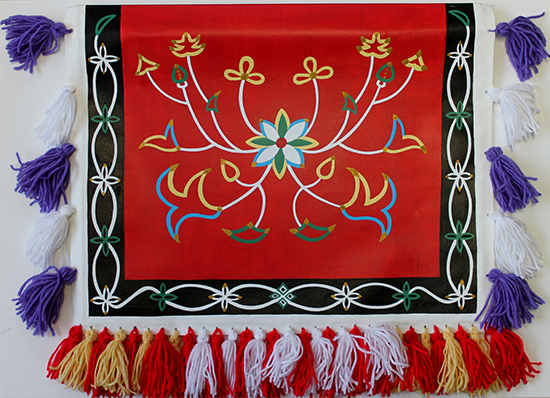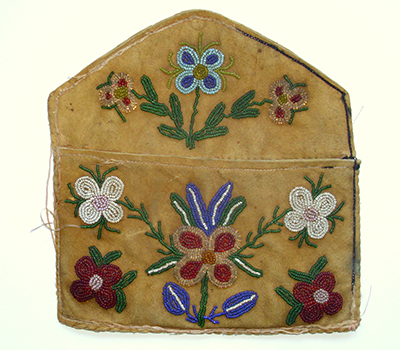Ukjese van Kampen.
Dr. Ukjese van Kampen traces in his doctoral dissertation the origins of the floral bead styles that his people from the south-central Yukon adopted in the mid-1800s. The Yukon First Nations people had an established floral embroidery tradition already before Europeans entered the area in the end of the 19th century. However, the floral designs were not indigenous but adopted through a centuries-long process. The dissertation gives new insights into the spread of floral designs originating in 1500s France and migrating westwards across Canada to the Yukon.
The Yukon Territory is situated in the northwest corner of Canada. It is the home of the Athapaskan and Inland Tlingit peoples. The area remained unexplored until the mid-1800s. At the time of the colonial take-over of the Yukon by the Dominion of Canada in the late 1800s, Yukon First Nations people already had an established floral embroidery tradition. It was obvious that the floral designs were not indigenous and that they were adopted sometime after the mid-1800s. Before floral designs, the Yukon First Nations people created a geometric style of imagery that was applied to their clothing and tools. So: Where did the floral designs originate from and how they became a part of their embroidery tradition?
Dr. Ukjese van Kampen shows in his research how the floral embroidery designs used regionally in 1600s France arrived in Yukon. In addition, the research examines the patterning traditions by the First Nations peoples from geometric design to different styles of floral designs.
"The Cree/Métis people were the first to bring the floral designs into the Yukon region. They were from the great plains of Canada and were brought to the north by the Hudson’s Bay Company to assist in the trading activities of the company", tells Dr. Ukjese van Kampen.
They had adopted floral designs from indigenous peoples further east, and used what Dr. van Kampen defines as the Cree/Métis ‘A’ style. This style is identified by generally having a central main flower with thin stems radiating out from the central flower to smaller secondary flowers. Along the stems are often leaf designs sprouting from the stem or secondary stems that lead to other flowers. There is a lot of the background showing through.
"The Yukon-Alaska Han and my own Northern Tutchone Athapaskan people from the Upper Yukon River region adopted that Cree/Métis ‘A’ style in the mid-late 1800s and it became known as the Upper Yukon River Floral style", describes Dr. van Kampen.

A painting showing the basics of the Upper Yukon River style of floral
designs. The painting is of the sled bag cover that is beaded with this
design. Ukjese van Kampen. Acrylic and wool on canvas, 2018.
However, the origins of the floral designs are much further away. They stem from 1600s France, where there was a long tradition of floral designs. The French regional and baroque styles were brought from France to New France by various Catholic orders, starting in 1639.
"The first Catholic order to arrive in New France was the Ursuline Sisters who taught the designs in their convents. These French styles were adopted by the Huron and Iroquois from present day provinces of Quebec and Ontario. Through diffusion, the styles spread west and north, eventually arriving into the Yukon", says Dr. van Kampen.

A Han beaded bag which dates from the late 1800s – early 1900s, Upper
Yukon River style. The personal collection of Ukjese van Kampen.
Floral designs became simpler when they turned to an income
From the mid-1900s to the present, dramatic changes in designs used by the Yukon First Nations have taken place.
"The colonial effects of the Canadian Government’s policies affected the lifestyle and culture of First Nations people. The floral designs were also affected. They were then often being made to sell for income and not for ceremonial purposes. The floral designs became simpler and standard designs were created for ease of selling", tells Dr. van Kampen.
In addition, floral beading as well as small animal carving and drum painting that men did were not considered art but crafts.
"There was little formal research on the earlier floral designs until the late 1900s by which time the earlier floral designs were no longer being created. This dissertation aims to give the big picture of the earlier floral designs that were adopted by Yukon First Nations people in the second half of the 1800s", he points out.
Information on the public examination
The academic dissertation Origins of Yukon First Nations Beading Styles: Searching Floral Patterns from 1500s France to 1800s Yukon by Dr. Ukjese van Kampen will be publicly examined in the Faculty of Art and Design at the University of Lapland on Friday 22 April 2022 at 12 noon, in the Esko and Asko hall. The opponent is Professor (emeritus) Markku Henriksson, and the custos is Professor Tuija Hautala-Hirvioja from the University of Lapland
The public examination can be followed online at https://blogi.eoppimispalvelut.fi/ulapland
Information on the doctoral candidate
Ukjese van Kampen is the great-grandson of well-known Elder Annie Ned and great nephew of Elijah Smith who promoted actively the rights of Yukon First Nations people since 1970s. Both are members of the Order of Canada. It was Annie Ned who gave Ukjese his name, believing he was the reincarnation of her deceased husband Ukjese (Johnny Ned). Ukjese is from the Wolf Clan, Northern Tutchone people.
He has a BFA and a MA in Cultural Studies. His first PhD in Archaeology, "History of Yukon First Nations Art", is from the Leiden University in the Netherlands. He is the second Yukon First Nations person to earn a PhD and the first Northern Tutchone to do so. With this PhD in Art and Design, he will be the 1st Yukon First Nations person to earn two PhDs.
Ukjese van Kampen is an artist who has had over 100 group and solo exhibitions worldwide. His art is in a number of museums around the world including in the Finnish National Museum.
In addition, he has served as an Airborne Commando in the Canadian Army, a Combat Engineer in the United States Marines and later as a Canadian Air Force Reserve officer. He is the 2nd Yukon First Nations person to earn a Canadian Commercial Pilot Licence and later he earned an Airline Transport Pilot Licence. He has worked as a Bush Pilot and Flight Instructor and started the 1st 100% First Nations owned aviation company in the Yukon.
Further information
Dr. Ukjese van Kampen
tutchoneart (at) yahoo.com
Information on the publication
Ukjese van Kampen: Origins of Yukon First Nations Beading Styles: Searching Floral Patterns from 1500s France to 1800s Yukon. Acta electronica Universitatis Lapponiensis 324. Rovaniemi 2022. ISBN: 978-952-337-287-0. ISSN: 1796-6310
Permanent address of the publication: https://urn.fi/URN:ISBN:978-952-337-287-0